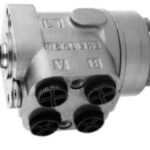Task of hydraulic filters
To ensure trouble-free operation in hydraulic systems, the use of hydraulic filters is essential.Practice shows that about 80% of all premature failures of hydraulic systems are due to a contaminated pressure fluid. The task of the hydraulic filters is thus to reduce this contamination to a minimum.
Causes of contamination of hydraulic systems
There are two possible causes, internal and external contamination of hydraulic systems.
Internal contamination is caused by particles generated in the system, e.g. abrasion in the components, rubber particles from hose lines, aging residues in pressure fluids (often caused by high working temperatures of the hydraulic medium).
External contamination of the hydraulic medium occurs, for example, during system assembly (e.g. during assembly of hydraulic fittings), through poorly sealed hydraulic tanks or through unsuitable air filters.
Structure of hydraulic filters (filter elements)
1.) Surface filters: These filters consist of a thin layer of fabric, e.g. metal, cellulose or plastic fabric or paper. To increase the effective area, the thin filter layer is folded in a star shape. Wire cloth filter elements offer high strength combined with low flow resistance and are washable. The standard filter finenesses are 25, 60 and 90μm
2.) Depth filter: The liquid to be cleaned penetrates the filter structure. The particles to be removed remain trapped in the deeper layers of the filter. The particles to be removed remain trapped in the deeper layers of the filter. For the highest demands, a microfiber fleece is usually used. The exact filter performance is determined using the so-called multi-pass test method. By using glass fiber elements, a depth filtration effect of up to 1 µm filter fineness is achieved. Paper filters are the cheapest alternative of depth filters and are suitable for plants of simple construction. Hydraulic filters with paper filter element achieve filter finenesses of 10 and 25 μm.
Types of hydraulic filters
Return filter: This arrangement of a hydraulic filter is most often used in hydraulics. Return filters are built directly on the oil tank, return capacity filters are installed in the return line. The housings and filter element shall be designed to withstand pressure spikes that may occur due to abrupt opening of large valves, or to discharge directly to the vessel via a quick-response bypass valve. The entire return flow should flow back through the hydraulic filter. The disadvantage of this arrangement is that the contaminants are not detected until they leave the circuit. Backflow filters are used as main flow filters with a bypass valve connected next to it.
Advantages of return filters:
- Low cost
- Easy maintenance
- Equipment with contamination indicator possible
- Fine filtration options
- No pump cavitation
Disadvantages:
- Options for fine filtration
- Dirt particles can enter the hydraulic system during pressure peaks or cold starts when the bypass valve is open.
Suction filters are often installed in hydraulic systems in addition to a return filter. The suction strainers are installed directly below the oil level in the oil tank. This protects the hydraulic pump against damage caused by coarse impurities in the tank. Due to the sensitivity of hydraulic pumps to negative pressure, the pressure difference at the filter must not be too great. Therefore, large filter areas must be installed and the use of a bypass valve and a contamination indicator is strongly recommended.
Pressure filtersare installed downstream of the pump (i.e. on the pressure side of the hydraulic pump) and have the task of protecting particularly sensitive components (e.g. proportional valves, servo valves). This means that the filter housings must be designed for the system pressure of the hydraulic system.
Advantages:
- Mounting directly in front of sensitive (expensive) components
- Very fine filter finenesses possible
- Easy maintenance
- Equipment with contamination indicator possible
- Long service life
- No pump cavitation
Disadvantages:
- Expensive
- High weight due to robust construction
- Depending on the flow resistance, power is converted into heat
Tank breather filters (filling and ventilating filters): Although this type of filter has received little attention in recent years, filling and ventilating filters are an important component in the hydro plant. A considerable amount of contamination enters the hydraulic system through unsuitable ventilation systems. Design measures, such as pressurization of oil tanks, are today often uneconomical compared to highly effective aeration filters.
- Mobile control block - 13. May 2023
- Hydraulics lowering brake valves - 6. May 2023
- axial piston engines - 2. May 2023
